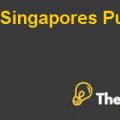
Supply Chain Management W'Up Bottlery Case Solution
The case examines the supply chain operations in the W’Up Bottlery. The company operates in the region of Uttar Pradesh India and is responsible to produce Coca-Cola and other beverages. This case evaluates the significance of Vendor Management Inventory and the impacts of this system on its relationship outside the company such as distributors.
The research entails the identification of the key issues that has aroused in the case,as well as detailed analysis has also been performed to examine the causes and impacts of these issues. Furthermore, this research also contains the answers of the given questions in the case. The answers examine that how VMI system should be implemented, what will be its impacts on the cost structure and how it would bring the resistance through its implementation.Finally, the last section of this research includes recommendations in order to resolve the issues in the system.
1. Case Study Summary:
The case is about the supply management of the W’Up Bottlery Company.
Inventories of the company had reduced, and the fill rates had improved to the previous peak sales season. The director of the supply chain, Rajat Mehra, was concerned to find such ways that could help the company to improve its performance noticeably.
· Information Regarding Company’s operations:
The W’Up’s plant made other flavors beverages as well such as, ThumsUp, Limca, Carbonated during and Maaza mango juice. However, the W’Up has two major sources of revenues, its 70% revenues came from returnable glass bottles, and other 30% revenues came from one-way packs. In addition, W’Up has twelve different stock keeping units in the RGB and OWP (one-way pack) business.
The products of W’Up were sold through a broad selection of retail channels. These channels were organized into six important categories including, restaurants, food courts and others. In addition, W’Up’s four plants that were serving the region of Uttar Pradesh market. It has its own storage facility in Uttar Pradesh. On the other hand, the W’Up had 800 distributors and 250000 independent retail outlets.
The large stores and supermarkets contributed only 3% to 4% of W’Up sales, howeverthe growing rates of this sector were very high. In addition, the direct distribution accounted 20% of the sales whereas, W’Up’s own fleet of a truck was responsible for shipping the products directly from W’Up plant storage to retail outlets. Furthermore, the indirect distribution accounted remaining 8% of its sales and in this distribution route, the products were shipped from W’Up plant storage to distributors and then to sub-distributors.
In the company’s terminology, the primary sales were those sales which came from the independent distributors; the secondary sales were those sales which came from the distributors to retail outlets and finally, the tertiary sales were those sales which came from retail outlets to consumers. The production that was carried out in the W’Up plan was in the batch process involved the major manufacturing and packaging of beverages, and the batches were completed during the day.
The glass trippage was the major key performance metric in the returnable glass business. The performance of the business was measured by the trip taken by a glass bottle per year. In simple words, the trip of a glass bottles means that how many times the bottle has returned to the plant for another filling process and to than to dispatch. (Brenda Platt, Project Director and Co-Author, 2002). However, optimizing glass velocity or trippage was the main concern for the director of the supply chain Rajat Mehra...................
This is just a sample partial case solution. Please place the order on the website to order your own originally done case solution.











